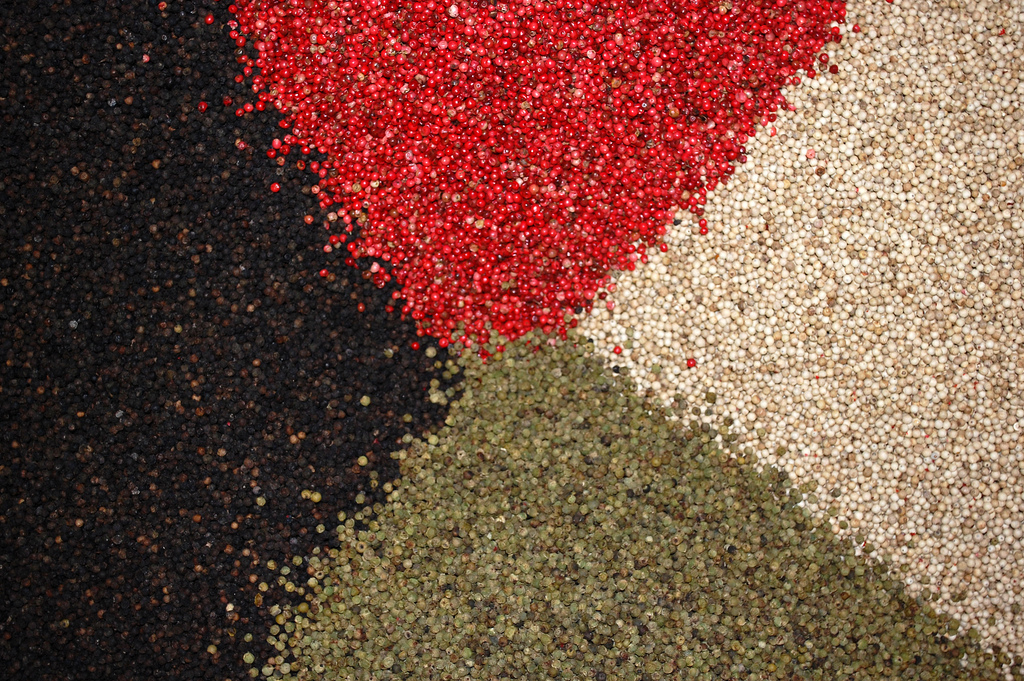Eat More Peppercorns
The Awl’s holiday series on flavors and spices.

Image: Steenbergs via Flickr
My favorite thing to eat in the entire world, aside from Ferrero Rocher bon-bons and flan, is a Szechuan dish called ma po tofu. Cubes of silken tofu and ground pork are cooked together in a spicy red sauce, thick with fermented black beans, chili oil, ginger and tiny, metallic, tangy Sichuan peppercorns. It is best served over rice and decidedly at its worst when served with peas—something I have only encountered once in the wild at a Chinese restaurant in Williamsburg that was featured heavily in an episode in the final season of “Girls,” when Hannah’s mother eats too many edibles and finds inner peace eating soup dumplings at a table, solo.
Eating the dish will eradicate your palate such that if you wanted to enjoy anything other than the taste of metal in your mouth, you’d be at a loss. Sichuan peppercorns are a divisive spice. You either hate them and will assiduously pick them out of any dish where they might be present, or you love them unabashedly, crunching the little fuckers between your teeth and releasing the their tingling essence. A sichuan peppercorn is the epitome of ma-la, roughly translating to “numb-hot,” because that is the sensation that occurs when you eat one. Sweat breaks out on your upper lip, but it’s not the searing-white heat of a ghost pepper or the tangy acid of a Scotch Bonnet. There are never tears, just an overall feeling of heat, of numbness—absent the nose-tickling anticipatory hell of black pepper or the floral and slightly dusty mouthfeel of white.
Sweet tastes like the earliest stages of decay; sour is an immediate cry for mercy. Hot-sauce–spicy is torture and feels more like the purview of Guy Fieri super fans. Pepper is heat; it is piquant and not violent. It makes almost everything better: mac and cheese with cut up hot dogs is elevated to something haute cuisine when covered in a healthy grind or five of crushed black pepper from a disposable McCormick’s grinder. Consider the peppercorn—the Sichuan for special occasions, the black for your salads, and the white for just about everything else.
A white peppercorn is not actually a peppercorn like a Sichuan peppercorn or a black peppercorn—it’s a mature pepper berry that has been soaked and fermented for two weeks, until the little skins fall off and all you’re left with is the inner seed. It’s the essence of pepper, earthy and spicy and warm and much more interesting than the sad little specks of black pepper that sits on top of your stove. Where black pepper is a bottled sneeze, white pepper is nuanced—it’s not smacking you in the face, screaming “DO YOU HAVE SOME HOT BUTTERED CORN I COULD HANG OUT ON?” like black pepper does. It wants to be everywhere, but it doesn’t want to yell about it. It’ll be happy wherever you put it, and your life will improve for the better.
Like the vocal stylings of Christina Aguilera, I always want my food to do the absolute most. A proffered black pepper grinder from a bored man in a fancy shirt at a restaurant is stressful: of course I want the pepper, but I want it all. Leave the grinder on the table and walk away. At home, I am free to spice my food however I please. I will shower a sad dinner-adjacent meal of, say, one piece of slightly stale sourdough rubbed with garlic, covered in a shredded “Mexican” cheese blend, and stuck in the toaster oven until everything melts with white and a dash of black. The result still tastes like an ersatz grilled cheese (because it is), but something about the white pepper makes it feel fancier. Add white pepper to your soup, serve your soup to your pickiest friend and ready yourself to lean in and whisper, “It’s just some white pepper” when they ask you how and why your soup tastes like hot and sour soup in a good way when it is clearly anything but. Pepper is an easy way to convince people you really know how to cook; black pepper is what they’re expecting. No one thinks of white pepper. You’ll stump your asshole food friends who sip braising liquid from pots of beans and ask in increasingly insistent tones whether or not there is soy in the broth. With your food happily laced in white pepper, they will eat with a furrowed brow, rifling through their personal spice archive to figure it out. They will not figure it out and you will feel good. White pepper does the heavy lifting so you don’t have to.
Add it to eggs. Add it to a vinaigrette. Toss a tiny bag-of-cocaine’s-worth into a bone broth, you jerk, smash some ginger with the flat side of your knife and toss that in, too. Improvise a panic breakfast when all you have are two eggs, a weird tomato and three limp green onions: Softly scramble the egg with more white pepper than you think is necessary, and jiggle it around in a pan over low heat with the tomato and green onions, roughly chopped. Eat this over a clump of two-day-old rice, leaning your back against the sink. It will taste better than you expected—complicated and earthy. We all know that it’s bad to worship at the altar of kosher salt, no matter how tempting it might be. Take the pepper instead. Let the white pepper in.
